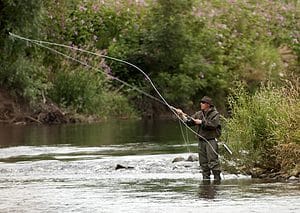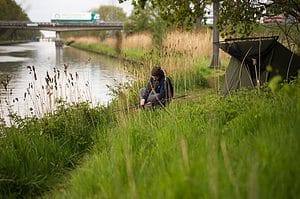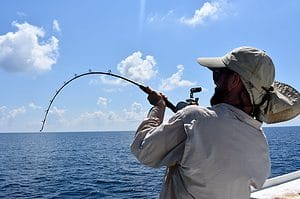Disclosure: Some posts contain affiliate links, which earn us a commission if you make a purchase through them. Positive Fishing © participates in various affiliate networks including the Amazon Services LLC Associates Program.
If you’re new to fishing, chances are you will read and hear many fishing terms that don’t make any sense to you.
Fishing is probably a sport with more of its own terminology than any other, making it hard to understand what fishermen mean, especially when you’re trying to learn how to fish.
I will run through the most common fishing words and terms in this article. I will split fishing terminology across fly fishing terms, freshwater fishing terms, and saltwater fishing terms so that you can understand all about these fishing words that anglers are always discussing.
Fly Fishing Terms

Fly fishing is a method used in saltwater and freshwater where you try to imitate the types of food the fish naturally eats. This artificial food is usually a type of fly or midge. The most popular fish caught using the technique of fly fishing are trout, salmon, grayling, permit, and bonefish.
Fly fishing is very different from any other kind of fishing, and therefore it has unique fish terms. Here are the ones to be most aware of:
Back Cast
This is fly casting, but it refers to the point during the cast when your fly rod is going backward past you. You can be asked to make a back cast which means ending your cast on your backward stroke.
Cast
This is the action of casting your fly rod using fly-casting techniques. To learn more on learning how to fly cast, check out my article here!
Fly
This is the bait you attach to the fishing hook. The bait is made from feathers tied around the hook in fly fishing. A fly can imitate an insect, fish, crab, shrimp, worm, and most natural bait.
Forward Cast
This refers to the point in your cast when your rod moves forward in front of you, and a fly instructor could say you’re going too low on your forward cast.
Leader
This is the piece of clear monofilament or fluorocarbon line you add to your fly line. They are usually about 9 feet long on average.
Leader (Tapered)
Almost every fly fishing leader is a tapered leader, and this means it starts with thicker mono/fluoro at the fly line end and slowly gets thinner and thinner. This allows your fly to turnover in the cast more easily for a better presentation.
Mending
Mending your line means moving it up or downstream on a river to correct the drift of your fly. Your line can often be caught in different currents compared to the fly and cause it to drift in naturally. By mending, you correct this to make the fly look natural to fish.
Retrieve
This describes how you retrieve your fly in by pulling or retrieving the line. You can do a quick, slow, or mixture of retrieves.
Rise
When a fish, usually a trout, but it can be any fish, eats a fly off the surface. The whirl left behind is called a rise, and fly anglers will often say a fish was rising over there.
Strip
When you strip a fly line, you pull it, and the fly back towards you, like a retrieve.
Strip Set
This refers to setting the hook into a fish by stripping, or pulling, the fly line. This is how you hook fish in saltwater or when fishing for predators like pike.
Tailing Loop
A tailing loop happens when you are casting badly and when it forms, your fly line doesn’t straighten out, and the presentation of your fly is not good.
Tippet
Your tippet is 3 feet of fluorocarbon you attach to your leader and tie your fly to on the other end. It’s meant to be the thinnest and least visible bit of line in your fly setup, so the fish don’t see the line.
Trout Set
This is lifting your rod to set the hook when a fish eats your fly, and is usually done in freshwater and mainly for trout.
Weight
Weight in fly fishing describes how heavy or light the fly rod, fly reel, and fly line you are using is.
The fly fishing weight scale runs from 1-16, from light to heavy, with weights in the 3-7 range being used most often. A common weight rod for trout would be a 5-weight.
It would be best to match the weight of your rod, reel, and line, to cast effectively therefore, use a 5-weight fly line and 5-weight reel with a 5-weight fly rod.
You can learn more about fly rod weight and action here!
Freshwater Fishing Terms

Fishing in lakes, ponds, or rivers where the water has less than a 0.05% salinity level is called freshwater fishing. Popular fish such as carp, trout, pike, and catfish can be found in these waters.
Action
This describes the action of your rod and goes from slow to extra-fast action. Action means where along the rod it will bend, so a fast action rod bends near the tip and is very stiff, while a slow action rod bends at the butt and is very bendy.
Artificial Lure
A man-made lure that looks like a fish or something else a fish might eat that is not a natural dead or live bait.
Bail Arm
The bail or bail arm is a stiff wire on a spinning reel that you open to cast and close to reel in.
Bait
This is anything you bait your hook with, ranging from sweetcorn to maggots, worms, boilies, and more.
Baitcasting Reel
A reel that doesn’t have a bail to spin the line onto it, and instead, the line is wound directly onto the spool.
Barbless Hook
A hook used in catch-and-release fishing that has no barb.
Bird’s Nest or Backlash
This describes a tangle where the reel spool has continued to spin under no drag force, creating a mess of line that looks like a bird’s nest. Try to avoid this as much as possible, as it will be a nightmare to untangle.
Buzz Bait
A type of artificial lure with a rotating blade that causes a lot of noise in the water and is usually used for catching bass
Float/Bobber
A device you add to your line that causes it to float under which you place your bait. This allows you to have your bait at the desired depth in the water.
Line Spool
This is the part of the reel where the line is wrapped around. It is what lets the line out and allows you to bring it back in.
Lure Action
This describes how an artificial lure swims, which can have good fishy action or a not-so-fishy bad action.
Power
This describes the power of your rod, which means how strong it is and how much it will resist bending under strain. The power range goes from ultralight (bendy under strain) to extra heavy (hard to bend under strain).
Sinker
A weight made of lead or other metals is added to a fishing line and designed to sink a hooked lure or bait.
Soft Plastic
A type of artificial lure that you add to a hook is soft and wiggly. These lures are made to have better action and feel more natural to fish when they bite.
Spinner
A type of artificial lure that has a spinning blade at the front of it to attract fish
Spinning Reel
A reel that goes up and down and with a bail that spins at the same time adds line to the spool of the reel – this is the most common type of reel in freshwater.
Saltwater Fishing Terms

Fishing in the ocean, typically from the beach, boat, rocks, or a pier. Common fish caught in saltwater include mackerel, tarpon, bonefish, cod, and permit.
Circle Hook
A hook that is shaped like a circle is designed only to hook fish in the mouth even if they swallow it. This is the best hook to use when fishing with bait as it won’t harm the fish and hook them too deeply.
Ebb Tide
This is when the tide is going out, also called a falling or dropping tide.
Flats
These are areas of shallow water that can go dry during low tide. You can have sand flats or grass flats, and they are often sight-fished for species like tarpon or bonefish.
Flood Tide
This is when the tide is coming in, also called an incoming or rising tide.
Free Spool
This refers to letting your reel in a setting where there is no drag, and the spool can go in either direction. Used to allow a fish to eat dead or live bait before hooking it.
High Tide
When the tide is at its highest or fullest point.
Inshore
This term refers to fishing inshore, which is close to the shoreline in mangroves, around flats, and inside the reef.
J-Hook
A normal hook that looks like a J that is used in trolling lures.
Low Tide
When the tide is at its lowest.
Neap Tide
When only the moon is causing the ocean to be moved by gravity and therefore creating smaller tides, this usually occurs two times a month.
Live Baiting
A method of saltwater fishing where you let live fish attached to a hook and line swim around until they get eaten. It is very effective.
Offshore
This term refers to fishing offshore outside of the reef in deeper water and up to 100 miles or more out to sea.
Riggers
On a sportfishing boat, you will have three riggers, two outriggers, and one center rigger. You attach your lines to the riggers when trolling, and they are used to spread the lines out, so they do not tangle.
Rigging
This refers to how you set up or “rig” your baits, line, lures, reels, rods, etc.
Spring Tide
This is when the moon and sun are aligned, creating a greater gravitational pull on the ocean and creating bigger tides. This usually occurs two times a month.
Trolling
This involves pulling lures or baits behind your boat to make them swim. Usually, you troll at around 5-6 knots but sometimes 7- 10 knots when targeting marlin. It’s also an excellent way to cover ground and find fish.
Terming Out
Thanks for reading my article. I hope you enjoyed it and can now understand a lot more when the most popular fishing terms are being flung around.
Please share it around with your fishing buddies, and check out some of our other articles – we cover everything from the best fishing gear to all kinds of bait articles and take you to all the best fishing destinations.
- Top Tips For Fishing With Feathers - January 15, 2025
- How To Fish For Flounders: Tips, Rigs, & Baits - March 27, 2024
- Fortis Wraps Fishing Sunglasses: The Affordable Option For Anglers - January 25, 2024

